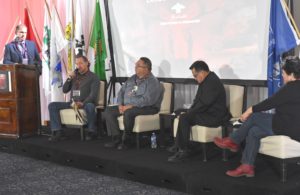‘The Environment shouldn’t suffer’ says Nipissing First Nation Chief

By Kelly Anne Smith
NORTH BAY— Speaking on the opening conference panel of the 2016 Lands and Resources Forum, the Chief of Nipissing First Nation told the packed hall, “The environment shouldn’t suffer from the conflicts we have with each other.”
Chief Scott McLeod is lamenting on the state of Lake Nipissing’s walleye fishery.
The numbers have declined to the point that Nipissing First Nation called for the winter walleye season to be closed for the year. The commercial season was shuttered August 31. There was uproar from the non-Indigenous recreational fishery and the tourist outfitters over the possibility of no ice fishing in 2017.
The Ministry of Natural Resources and Forestry (MNRF) commissioned an independent scientific panel to study data compiled by the ministry and Nipissing First Nation Fisheries department. Subsequently, the MNRF gave the okay to dust off the tip-up’s.
Dr. Mike Jones is the Panel Chair of the study, “External Review of Lake Nipissing’s Walleye Fishery and Management.”
Reached in Anchorage, Alaska, Dr. Jones discussed the conclusions.
“The levels of harvest that they are recommending, both recreational and commercial and First Nation harvest – we believe the levels are consistent with a healthy walleye fishery,” stated Jones.
Jones is cautious; however, that if harvest numbers are higher than reported, the fish could be at risk.
“The reason I framed that sentence that way is because that has not been the case in recent years,” stated Jones. “The information that was shared with us suggested that the actual harvest in recent years have been much higher than the recommended harvest. So we stated, if you can meet that objective, we would be cautiously optimistic about the fishery. But if you don’t meet that objective, we are at least as confident that the fishery will continue to be in very bad shape and probably get into worse shape.”
Nipissing First Nation Chief McLeod was disappointed with the decision saying the MNRF is saying more studies are needed.
“That doesn’t fly with me,” added Chief McLeod. “They have studies already that aren’t that old that show mortality rates. They are talking about what are the effects of those mortality rates. They are not managing fish. They’re managing people. That’s what they are doing. The tourist outfitters are mad.”
Chief McLeod is critical.
“They’ve created a winter fishery where the bag limit is only two,” continued Chief McLeod. “But the fish they force the angler’s to target are not even in the lake. Those are the fish that are missing. They say you can keep two fish over 17 inches. The older fish, the bigger fish, those fish are not even there.”
“The problem is that the fisherman will go and spend all day there catching and releasing fish. I’ve heard stories of 50 or 60 fish. Well the mortality rate of that by their own studies is that 20 percent of those are going to die,” added Chief McLeod. “So the bag limit is two, but how many fish are they killing if they catch sixty -more than two! It would make more sense to say after the first two fish you catch that is it, you’re done.”
Dr. Jones says it is difficult to measure the mortality rate on fish that have been caught and released.
“It depends on how many people are fishing and what the first two fish caught would look like in terms of their size,” noted Jones. “There has been research where they caught fish and put a tag on it and measure how frequently they recovered those tags. That research showed a high survival rate. So there isn’t a huge risk on catch and release walleye.”
Chief McLeod says the fishermen in the coffee shops say it’s not even worth going out anymore.
“They say because you can’t keep any of them,” stated Chief McLeod. “But they still go out. So it is really bad faith legislation. They are only keeping it open for the tourist operators. And that’s sad because the fish are being put on the back burner in all of this.”
Chief McLeod says the report is missing the recent implementation of the Memorandum of Understanding (MOU) with MNRF.
“We signed the MOU in November 2015 and in 2016 we fully started to implement it,” noted Chief McLeod. “There is nothing to show the efforts we put forth in near 100% compliance in the moratorium when we had no fishing occur. And we increased compliance in measures put in place in conjunction with the ministry and with the Anishinabek Police Service.”
There is nothing in this report that reflects that,” continued Chief McLeod. “We have been taking measures into our own hands. We have been pushing for reducing and maintaining a sustainable limit. We didn’t create this problem. We are trying to deal with it.”


